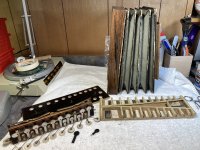cass
Member
hi all. another new project. have a friend who passes on flea market accordions to me. it's fun for him and keeps me busy and learning. latest is a flutina. I know it is not technically the right name but minor point there. It is a Busson, with an 1871 date on the bellows. It is very nearly complete, missing some keys covers, one reed and a metal mesh shield for one end of the keyboard. the bellows has at least one significant hole and probably lots of smaller. cleaning it up and replacing the pads shouldn't be too bad. I have made a couple of key prototypes on my 3D printer (currently no white filament on hand). I can fluff up the interior leather seals and the leathers are mostly flat. I would prefer not to remove the keys from the axle if I don't have to, but will address that when the time comes.
If anyone who has experience with one of these instruments has words of wisdom or advice to offer, I would certainly appreciate receiving it.
thank you.









If anyone who has experience with one of these instruments has words of wisdom or advice to offer, I would certainly appreciate receiving it.
thank you.











